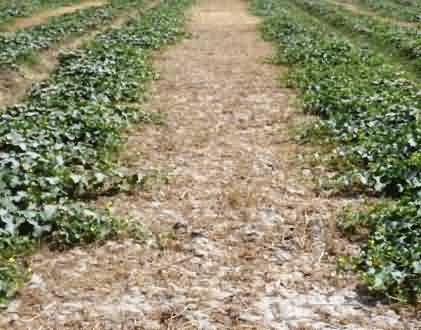गेहूं - कद्दू वर्गीय फसलों की रिले अंंत:फसल के माध्यम से किसानों का लाभ बढ़ाना
Rice-wheat is one of the major cropping sequences being practiced on about 10.2 m ha area in India. The wide adoption of this system is mainly due to low risk of crop failure, good marketing facilities and better minimum support price. This system is very important for the national food security.
To adequately address the nutritional security of the people, it is pertinent to increase the production of different vegetables and fruits. Owing to explosive increase in population and faster urbanization, it is very difficult to bring more area under vegetable and fruit cultivation.
Also, the decreasing per capita land availability and increasing input costs have decreased the income and profit margins of the farmers. One of the ways to increase the farmer’s income is by increasing the cropping intensities following different cropping patterns.
 In past, the options tried for intensifying the rice-wheat cropping system were rice-rice-wheat, rice-wheat-greengram, rice-wheat-cowpea, rice-wheat-sorghum, rice-vegetable-wheat etc.
In past, the options tried for intensifying the rice-wheat cropping system were rice-rice-wheat, rice-wheat-greengram, rice-wheat-cowpea, rice-wheat-sorghum, rice-vegetable-wheat etc.
Now, the governments of Haryana and Punjab have banned the cultivation of the summer rice due to fast depletion of the underground water. Also, some times, owing to early onset of monsoon as well as problem of manual picking and threshing of pods are posing hindrances to adoption of the summer greengram and cowpea in wheat rotation.
Moreover, growing of vegetable pea after rice delays the wheat sowing leading to substantial wheat yield loss.
The sowing of crops like muskmelon, ashgourd, pumpkin etc. after harvesting of wheat in April encounters the problems of high temperature during early vegetative growth stages and risk of quality deterioration of fruits owing to early rains in June.
To address these issues of water shortage; and for increasing profit margins of the farmers, a new agronomic intervention of relay cropping of cucurbitaceous vegetables in wheat has given promising results and is being appreciably accepted by the farmers in Karnal and Panipat districts of Haryana.
Relay-intercrop Technique:
In relay cropping, the life cycle of the second crop overlaps with the cropping cycle of the first crop. Under this technology, cucurbits crop is sown either by seed (35-40 days before harvesting of wheat) or by transplanting the seedlings on the channels (25-30 days before harvesting of wheat).
The seedlings of cucurbits are raised in the polythene bags during the first week of February and are transplanted in the wheat crop in strips by clearing the 4-5 wheat rows at around 7.0- 7.5 meter intervals and transforming the cleared area into long channels (about 8 channels/acre) during the last week of February.
The immature wheat crop harvested is used as animal fodder. On the both sides of the channel, 20-25 days old seedlings are transplanted and the channels are used for irrigating the wheat as well as the relay intercrop of cucurbits. By the time, the cucurbit vines starts spreading, the wheat crop is ready for harvesting.
After the wheat harvest, the field is covered by the cucurbit crop. Harvesting of fruit starts after 90-100 days of seed sowing or 70-80 days of transplanting depending on the cultivars.
The crop is harvested by end of June. Growing of cucurbits as relay intercrop in wheat results in reduction of wheat yields by 10-13 %; this reduction in wheat yields is adequately compensated by these vegetables in terms of monetary gains. The comparison made among wheat-green gram (as sole crop) and wheat - muskmelon, wheat - ash gourd (as relay-intercrop) showed higher profitability in later crop rotations.
Also, the growing of cucurbits in channels uses less water and helps in soil conservation. The inclusion of crops like ash gourd and pumpkin as relay intercrop provide the farmers an alternate for one time marketing of the produce.
While, the inclusion of vegetables like muskmelon, spongegourd, bottlegourd etc. provide the farmers with an opportunity for access to regular income for meeting the day to day household needs. With this relay-intercrop technique, growers are able to take a full crop of cucurbits in their wheat field up to June.
Thus, helping in increasing the area and total production of muskmelon, ashgourd, pumpkin, watermelon, bottlegourd etc.and also provide for more profit margins to the growers in wheat growing areas under north Indian plains.
Authors:
R.S.Chhokar and S.C.Rana*
DWR, Karnal-132001(Haryana)
*IARI Regional Station, Karnal-132001
